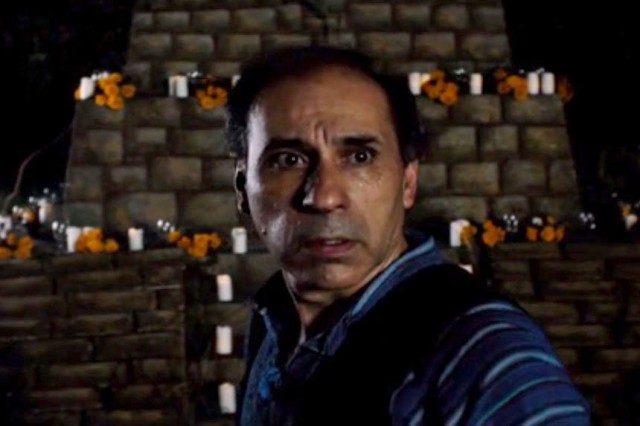
Dispatches, Mexico, North America
The Fight for Mexico City’s Future
March 2, 2015 By David Adler
MEXICO CITY — Around the corner from two taco stands and a small cantina, in an otherwise nondescript section of Mexico City’s Doctores neighborhood, there is an unmarked storefront known as the “Prepa Popular Tacuba.” On its outside, two large stencils frame the doorway. One depicts the Virgin of Guadalupe, melancholy, clinging to an AK-47. The other is of Emiliano Zapata, leader of Mexico’s biggest peasant revolution, scowling, looking outward. A poster below him carries the faces of Mexico’s missing 43 students.
Inside, in a large, dimly lit classroom, several leaders of Mexico City’s Urban Popular Movement convene for their weekly meeting. On the whiteboard, someone writes the details of an upcoming march in red marker. Others pass around copies of “Norma 26,” a law that regulates the construction of low-income housing in Mexico City. The rest of the members of the movement — a collection of local community organizations fighting for housing rights — sip instant coffee, eat biscuits and deliberate. “We must defend the city,” one leader said. “This is a matter of our right to the city, and we must defend it.”
On Jan. 29, the Mexico City Legislative Assembly (ALDF) announced the reform of Norma 26 through a special, express legislative process. Manuel Granados, president of the ALDF Government Commission, placed it on the agenda of the Assembly’s next “extraordinary session,” a special assembly meeting geared toward swift policy resolution. But the plan has backfired: politicians from all sides are making public statements against the reform, groups around the city are organizing mass demonstrations and fresh controversies have emerged about alleged abuses by powerful Mexico City real estate developers.
Far from concluding the political discussion, the Norma 26 reform has opened a far-reaching debate about the future of Mexico’s cities, and the place of the poor in them. On March 4, legislators and community organizations will meet to review the legislation, present proposals, and develop a new vision for low-income housing in the city.
At the weekly meeting in Doctores, Jaime Rello, a representative from the Revolutionary Popular Union Emiliano Zapata, explained the terms of the discussion as his movement sees them. “The issue with Norma 26 is: do we want a city for everyone, or just for the privileged few?”
Solving segregation
The aim of Norma 26, according to its legislation, is to “incentivize the production of sustainable housing.” As part of the broader General Program for Urban Development Plan that governs Mexico City’s growth, Norma 26 is one of the only laws promoting the construction of housing stock for Mexico City’s low-income residents. “Norma 26 is supposed to create options for people like us, with scarce resources,” said Jesús Ríos Racilla, a leader of housing rights organization Urban Alternatives, in an interview. “The pueblo has nothing else.”
In order to do so, the law lays out two types of guidelines. First, the law contains metrics to define “low-income housing,” including ceilings on rent that are responsive to Mexico’s minimum wage. Second, it lays out incentives like tax breaks and exemptions on building height restrictions are meant to encourage developers to take on these low-income projects.
To its promoters, Norma 26 represents an important step toward a more inclusive form of urban development. Mexico City, like many major cities in Latin America, is severely segregated by class. The wealthy occupy much of the city center, raising rents and pushing the poor toward the outskirts, where they find low-rent accommodation or build their own homes in “popular colonies,” slum settlements with little access to municipal services like water, sewers or electricity. According to U.N. Habitat, two-thirds of Mexico City lives in the slums, which ring the city in a sprawl of cinder blocks.
“Hacer vivienda es hacer la ciudad.” (To build housing is to build the city.) — Representative of the Urban Popular Movement.
In Cabeza de Juárez, a popular colony deep in the outer neighborhood of Iztapalapa, the challenges of life on the periphery are on display. Narrow passageways are lined with small plots containing brick homes with corrugated roofs. Access to clean water is limited, and the electrical system was built by the residents themselves. According to Cecilia Islas, a community leader in Cabeza de Juárez, “We have to help ourselves, because no one else is helping us.”
Yet despite the challenges of life here, migrants from other parts of the city continue to arrive. Asked about why they came, several residents of Cabeza de Juárez gave one reason: rising rents elsewhere. In popular colonies, residents can cheaply buy empty plots outright, while renting incurs monthly costs. This is what is called “death by rent,” a phrase thrown around often by housing rights activists in Mexico City.
Norma 26, then, plays a crucial role in reducing Mexico’s “death by rent” epidemic. “Norma 26 affects us a lot,” says Ms. Islas. “Real estate developers cannot charge so much for rent for people with such scarce resources.”
The growth of colonies like Cabeza de Juárez has generated major costs for the government. According to Mexico’s national Urban Development Plan, the cost of extending municipal services to the new settlements cropping up on the edge of the city is roughly 2.7 times the cost in existing settlements. New public transit lines and infrastructure projects also drain municipal budgets.
In response, Mexico City’s government has sought to densify the city. In 2001, mayor Andrés Manuel López Obrador launched Bando Dos, a policy initiative aimed at sparking growth and development in the four central boroughs. Bando Dos, however, ended up worsening the problem it was designed to solve. As a result of increased pressure on the real estate market, housing prices in the city center rose by an estimated 30 to 50 percent, according to a study published by the London School of Economics, pushing even more of the city’s low-income residents toward the periphery.
Norma 26 seeks to address the problem by encouraging new developments with space specifically reserved for low-income tenants. By establishing rent ceilings in new buildings, legislators hoped to draw the poor from the periphery and into mixed-income housing that will help to curtail urban sprawl and reduce the segregation of the city.
Corruption in the capital
As with most ambitious laws passed in Mexico, the aims of Norma 26 have been warped and corrupted beyond recognition. As one anthropologist at El Colegio de México observed, “In Mexico, the law is always a negotiation.”
Since its birth in 1997, real estate developers have used Norma 26 to make windfall profits through tax breaks. Developers offer apartments at the prescribed level, but attach additions, extra “fix-ups” or special “deals” that push rent well beyond designated ceilings. A total of 78 percent of the “social interest” housing developed under Norma 26 failed to comply with price ceilings, according to statistics released by the Mexico City government. A recent investigation by city prosecutors revealed these abuses yielded gains of over 2.5 billion pesos– about $170 million.
“This is a matter of our right to the city, and we must defend it.”
Mexico City authorities responded by suspending Norma 26 in August 2013, replacing it with new regulations. Rather than incentivizing low-income housing directly, the government would use taxes on high-income developments to fund the construction of new low-income housing.
But the result was the same: developers used subsidies to build luxury properties, while they failed to demand low-income housing. In many cases, developers sold low-income properties at market value after price ceilings expired, prompting scathing criticism from the public and politicians alike.
The failure kindled discussions about reviving Norma 26.
“What we have and what is valid is Norma 26,” said Carlos Hernandez Mirón, president of the Development and Urban Infrastructure Commission of the ALDF, in November. “And we are proposing to strengthen it, give it more elements, add an element of punishment directed at the violators of the norm, to give it teeth.”
Voicing dissent
Local community organizations, however, see the new reform as a step in the wrong direction. Following the announcement, civil society groups like “Vecinos Unidos” (Neighbors United) and “Suma Urbana” (Urban Sum) gathered outside the Legislative Assembly with microphones and canvas signs to address Miguel Ángel Mancera, the mayor of Mexico City. “Mancera! Mancera! El DF no se vende,” they shouted, or “Mexico City is not for sale.”
The ire of these civil society groups stems from their exclusion in the process of drafting the reform. According to Josefina MacGregor, one of the leaders of Urban Sum, the ALDF failed to provide a copy of the new reform until after it had been delivered to the media. “We asked to see a copy a month ago. We tried in a variety of ways, but never received a response,” she said.
Activists say the exclusion of citizens in the policymaking process is a dark reality of Mexican politics. It is, they say, another case of a law corrupted: while the Mexico City legislature has passed three laws of citizen participation, little space has opened up for substantive citizen input. At the most extreme, legislators push laws through in opaque “extraordinary sessions.” Civil society groups count themselves lucky if politicians host a forum to explain the motives behind new policies. The latter was the case for Norma 26, a forum scheduled for Feb. 13.
At the meeting of the Urban Popular Movement before the forum, several representatives expressed concern about showing up at all. They feared that the forum was something of a trap: by hosting a “citizen consultation” session, politicians could claim real legitimacy for the reform, as it had been constructed through citizen participation. “This Norma was not written with us in mind. What reason do we have to think they will start thinking of us now?” asked one community leader.
Yet despite the hesitation, Local organizations flooded the the Feb. 13 forum. Disparate groups came from across the city to express a wide range of concerns. Middle and upper class associations, for example, voiced their concerns about the destruction of their neighborhoods. Norma 26 threatens to stimulate major vertical construction, ruining low-rise local charm, causing a great deal of noise, and perhaps most disconcertingly to them, importing new low-income residents — a set of complaints also known as “not in my backyard.”
Alternately, other community organizations expressed concerns about where the poor fit into Norma 26’s vision of urban development. Norma 26 dictates a rent ceiling for “social interest” housing well above the capacity of Mexico’s low-income residents, ranging from 4,000 pesos ($269) to 16,000 pesos each month ($1080). “The poor are losing the city,” announced Victor Manzanares of the Popular, Social, and Citizen’s Congress at Friday’s forum.
In the wake of the announcement of a reform to Norma 26, a number of government agencies have spoken out against it. The Institute of Housing (INVI), for example, publicly rejected the proposal as “absurd.” Ignacio Cabrera, INVI’s executive director for promotion of housing programs, claimed that the existing proposal guarantees only “crumbs” for the poor. “We do not agree,” he said. “This must be a standard for the production of popular housing.”
Cabrera resigned shortly thereafter, signaling a major rift between the INVI and its government partners.
Leaders from the National Action Party (PAN) have also expressed outrage at the proposal, claiming that legislators merely “changed a period to a comma” from Normas 30 and 31. Even the PRD, the party responsible for putting the legislation on the table, backpedaled. Raúl Flores, leader of the Mexico City PRD, has since claimed that the Norma 26 proposal should only pass with the approval of all parties in the ALDF.
A victory for the voiceless
In response to the outpouring of dissent, the ALDF has taken Norma 26 off of the agenda for the extraordinary session. “The promise of this Legislative Assembly is to construct this document in a shared manner,” they announced in a press release. At the forum on Feb. 13, pieces of the initial reform were already highlighted, edited or struck through — including the section on the rent ceilings, a major victory on behalf of Mexico City’s low-income community organizations.
Legislators have given these organizations until March 4 to critique the existing proposal or draw up new proposals to bring to the negotiating table with ALDF. They will then reopen the discussion, prepared to revise Norma 26.
“Mancera! Mancera! El DF no se vende!” (Mexico City is not for sale.)
Yet the Norma 26 controversy has reopened much broader conversations about urban policy in Mexico City. Beyond the specifics of rent control and subsidies, some politicians are calling for the ALDF to reform Mexico City’s entire Housing Law. Others are demanding that the ALDF rethink the much broader Urban Development Law, which sets out the government’s vision for the city’s future — from transport and infrastructure to health and education.
Many local community organizations, for their part, are pushing for the government to take a more active role in reserving land for the city’s low-income residents. Rather than focus on incentives for big real estate developers to lend a helping hand, these groups are proposing that the government buy up plots of land to redistribute among the poor — a major shift in policy. As it stands today, the government merely offers loans to help low-income groups to finance their own housing projects. A more aggressive policy, activists say, would take the burden off the poor, and as a result, slow down the processes of gentrification and marginalization affecting them.
The city we want
Three days after Friday’s forum, the Casa y Ciudad community and research center is packed with neighborhood leaders and activists. A surprising number of groups and organizations are trickling in—from various class and geographical backgrounds—galvanized by the recent agreement to delay the passage of Norma 26 and eager to present their vision of the city for its upcoming renegotiation.
Luis Flores, a leader of the Popular Housing Coordinator, sits at the front of the table, furrowing his thick brow and pointing his finger out at the rest of the room. “This is about one question,” he announced. “What type of city do we want?”
There remains little consensus in Mexico City. Some suggest tweaking bits of the existing proposal. Others suggest tossing out Norma 26 but teaming up with real estate developers to draw up a new one. The more radical groups focus on how to remove real estate developers from the conversation altogether, supporting the “social production of housing,” or auto-construction, instead. It is an uncomfortable discord, to be sure. And as the meeting ends, it is difficult to imagine how this group will ever arrive at a new proposal by March 4. “These are very different ideas of how the city should look,” one representative tells me. “I mean, ideologically.”
As such, nobody can predict the outcome of the Norma 26 negotiations. But the irony of the episode is worth admiring: a gambit to sweep housing reform through the legislature generates one of the most widespread and diverse conversations about Mexico City and the question of what kind of city its resident really want.
The Urban Popular Movement is now planning a major mobilization for March 4, the day of the negotiation. The movement, along with many other civil society organizations, will draw hundreds, if not thousands of Mexico City’s residents from all corners of the city to the doorstep of the Legislative Assembly. With any luck, the protesters’ voices will make their way into the policy negotiations upstairs, generating a new Norma 26 to promote a new vision of Mexico City.
About David Adler
David Adler (davidrkadler@gmail.com) is a Fulbright scholar at El Colegio de México in Mexico City.








5 Comments
[…] Read more… […]
[…] following an incident days before in which an army general was kidnapped by the FARC, highlighting civil-military tensions that have otherwise mostly stayed in the […]
[…] add this one: “The Fight for Mexico City’s Future,” David Adler, Latin America News […]
[…] Read more at latindispatch.com […]
[…] For more about gentrification in Mexico City, and about the fight against one of the policies fueling it, read David’s piece that he published for Latin America News Dispatch back in March — “The Fight for Mexico City’s Future” […]
Comments are closed.